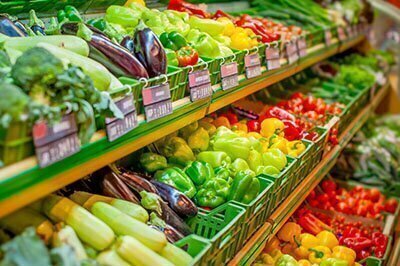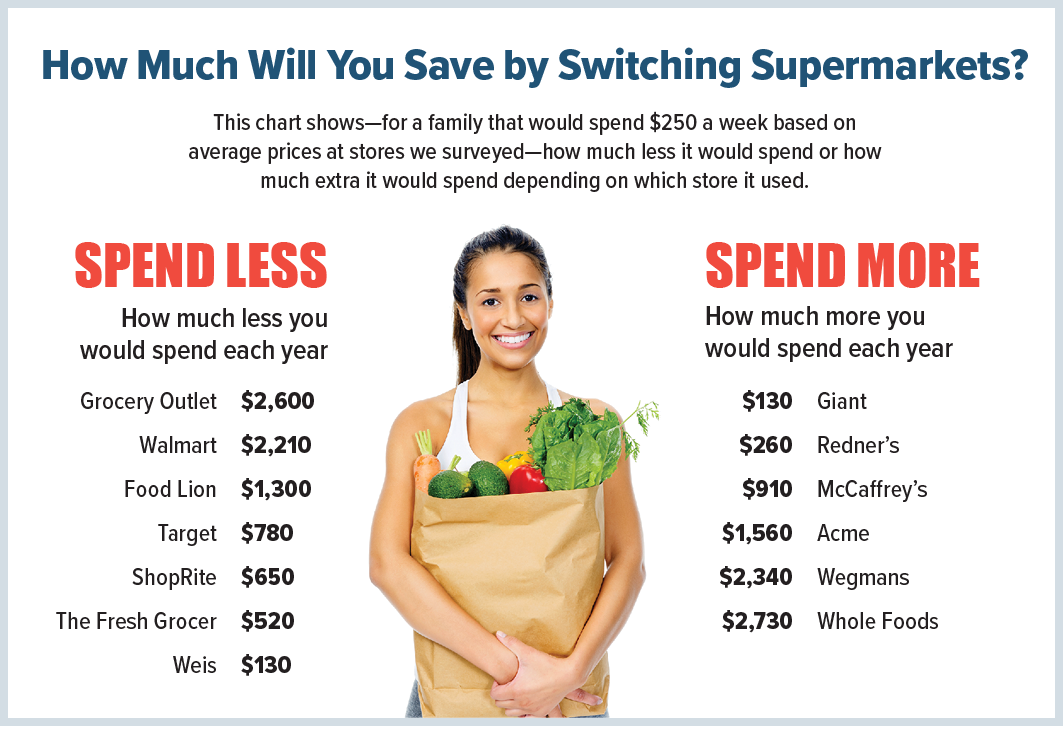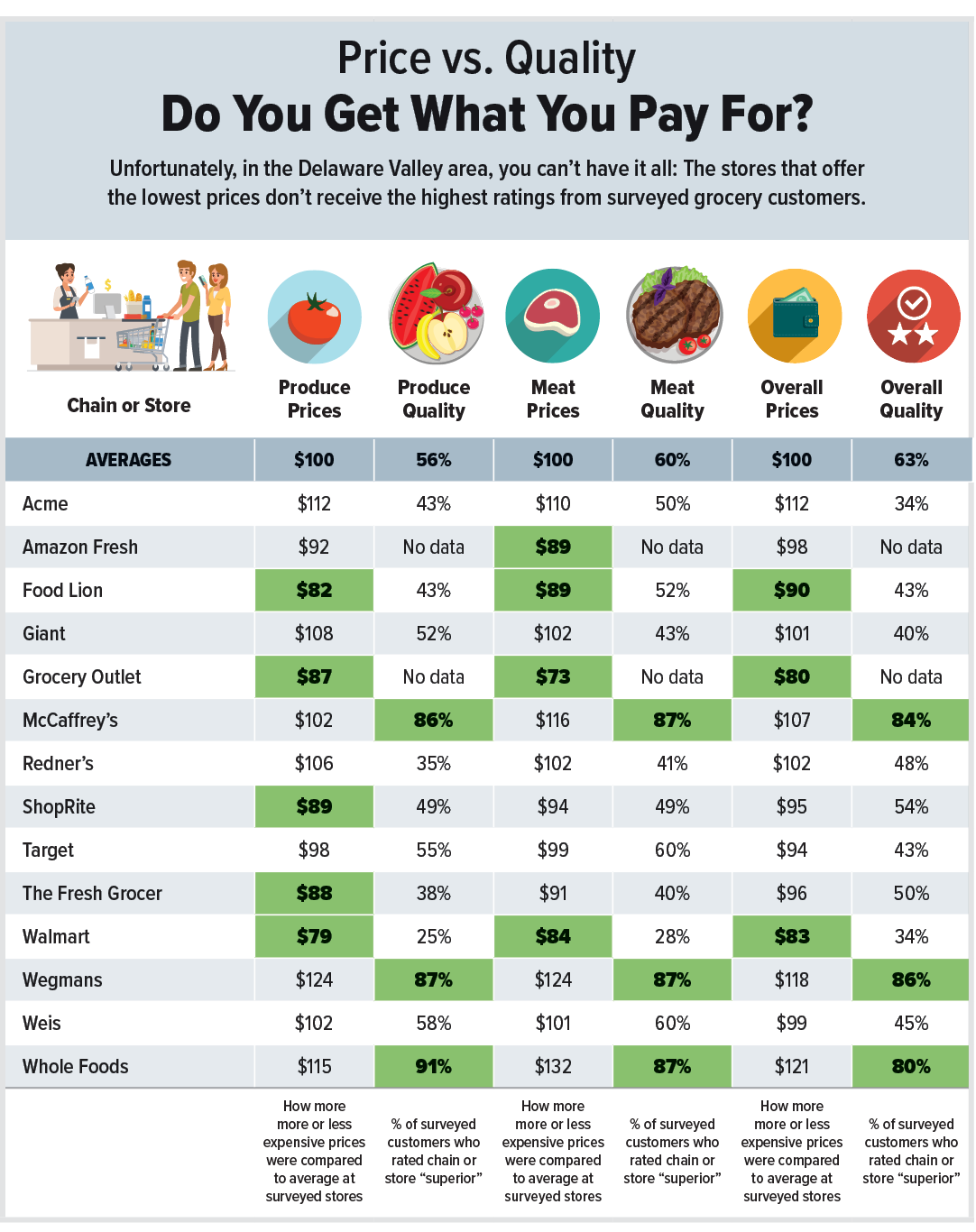Which Grocery Stores Offer the Best Prices and Quality?
Last updated November 2022
Click below to listen to our Consumerpedia podcast episode on how to save at the supermarket.
 Our ratings of Delaware Valley area grocery chains and stores report how each stacks up for price and quality. To compare prices, our researchers used a 154-item list of common items to shop area options. To evaluate stores on quality of products and service, we surveyed area consumers. The figures below summarize our findings; for details, see our Ratings Tables.
Our ratings of Delaware Valley area grocery chains and stores report how each stacks up for price and quality. To compare prices, our researchers used a 154-item list of common items to shop area options. To evaluate stores on quality of products and service, we surveyed area consumers. The figures below summarize our findings; for details, see our Ratings Tables.
Here’s a rundown of the results:
The area’s price standouts were Grocery Outlet, Food Lion, and Walmart.
Grocery Outlet, which offers a somewhat odd assortment of steeply discounted surplus national-brand products, offered prices that were about 20 percent lower than the average at all other stores we surveyed. Walmart and Food Lion were the other big savers: Walmart’s prices were 17 percent lower than average, and Food Lion’s were 10 percent lower. For a family that spends $250 per week at the supermarket, a 20 percent price difference could total more than $2,500 a year and a 10 percent difference would total $1,300 in savings.
Target was the next-best bet for low grocery prices (six percent lower than average).
Shoppers using Grocery Outlet will have to make another stop.
Although Grocery Outlet wins for price, it offers few options compared to other grocery stores: The location we shopped carried only 27 percent of the items in our market basket.

Whole Foods remains the area’s most expensive grocery chain.
When Amazon purchased Whole Foods in 2017, many consumers were excited by the prospect of paying Amazon-like prices for Whole Foods-quality products. That hasn’t happened.
Whole Foods built a loyal following by offering high-quality produce, meat, prepared foods, and generic staples, and has always earned high marks in our surveys of consumers, especially for produce and meat quality. But Whole Foods remains the most expensive grocery choice in the Delaware Valley area. The store we surveyed had prices that were about 21 percent higher than the all-store average, or 46 percent higher than Walmart’s.
Wegmans continues to impress its customers with high-quality products and service, but it now ranks among the most expensive grocery options in the area.
Wegmans has always consistently earned very high ratings from its customers for quality, and it continues to rank as the top area chain with our raters (86 percent judged it “superior” overall).
When we last compared prices of local grocery stores, in 2018, we found the Rochester-based chain that continues to methodically expand along the East Coast offered prices that were lower than most of its big competitors. But in our most recent survey, Wegmans’ prices indicated it is now among the most expensive grocery options in the Delaware Valley area—overall, its prices were 18 percent higher than the all-store average, and its produce and meat prices were each 24 percent higher than average. That places Wegmans in Whole Foods’ price territory.
We were so surprised by this result that we surveyed Wegmans a second time. We got a similar result.

Acme remains one of the highest-priced chains in the area.
Among stores we shopped, only Whole Foods and Wegmans offered higher prices than Acme. In our survey, Acme’s prices were 35 percent more expensive than Walmart, 24 percent more expensive than Food Lion, 19 percent more than Target, 18 percent more than ShopRite, 11 percent more than Giant, and 10 percent more than Redner’s.
Among supermarket chains, other than Wegmans and Whole Foods, only McCaffrey’s Food Markets got high ratings from its customers for quality.
Unlike in the other metro areas where we publish Checkbook, there are comparably few chains in the Delaware Valley area that get high ratings from their surveyed customers for the quality of their produce or meat or for overall quality.
Acme and Walmart received the lowest overall ratings in our surveys of consumers.
Only 34 percent of each of these chain’s surveyed customers rated it “superior” overall. Giant (40 percent), Food Lion (43 percent), and Target (43 percent) also received low overall ratings.
Although ShopRite did not receive stellar ratings for quality, it did get considerably higher ratings than Acme and Walmart.
Fifty-four percent of ShopRite’s customers rated it “superior” overall.
Within the largest chains, there is relatively little store-to-store price variation.
Prices at the Acme, Giant, and ShopRite locations we surveyed were about the same from store to store.
Whole Foods’ Amazon Prime discounts don’t add up to much.
Like most other grocery stores, Whole Foods uses “loss leaders”—widely advertised discounts on a small number of items—to draw customers into stores (when calculating our price comparison scores, we include sale prices). But with Whole Foods, there’s a twist: At checkout, Amazon Prime members can automatically get an extra 10 percent off items that are on sale, plus special “Prime Member Deals” for a small number of other weekly special items.
If you shop at Whole Foods often, the 10 percent bonus discount for on-sale items is a nice little benefit—although it’s unlikely many shoppers will rack up enough savings to cover the annual fee for Prime ($139/year or $14.99/month).
Sometimes Amazon/Whole Foods’ Prime Member Deals are designed to garner a lot of attention. For example, for Valentine’s Day the company has hyped that Prime members can buy two dozen roses for $19.99, instead of $24.99. But because Whole Foods and Amazon offer so few of these discounts (usually it’s only two or three items per week), they won’t save most shoppers much money overall.
You can save by buying store brands.
At most stores, when we substituted cheaper generic and store brands for about one-sixth of the items in our market basket, our total costs dropped by about five percent.
We also compared prices of organic produce and meat; checked out warehouse clubs; looked at unique stores Trader Joe’s, ALDI, and Lidl; and examined grocery delivery options.
Check out the other articles in our “Grocery Stores” category and our ratings tables for info on all the local grocery options, how we rated them, and tips on saving no matter where you shop.


